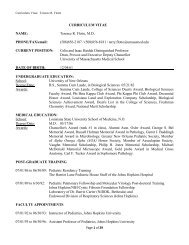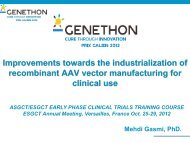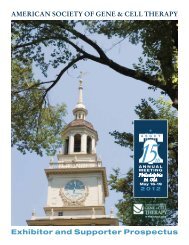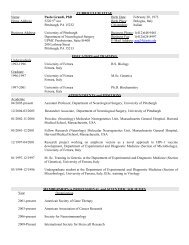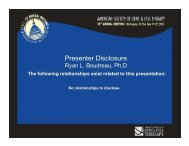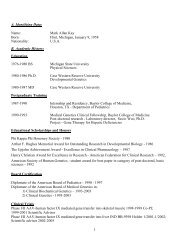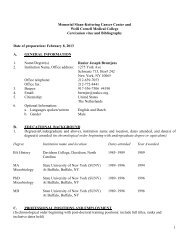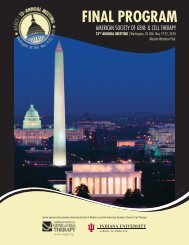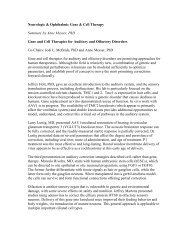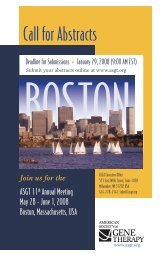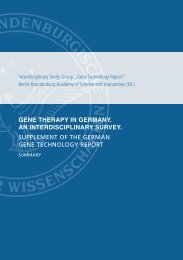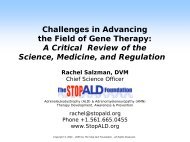Final Program - American Society of Gene & Cell Therapy
Final Program - American Society of Gene & Cell Therapy
Final Program - American Society of Gene & Cell Therapy
Create successful ePaper yourself
Turn your PDF publications into a flip-book with our unique Google optimized e-Paper software.
<strong>Program</strong> Schedule, Saturday, May 18, 2013<br />
Scientific Symposium 430<br />
1:45 pm - 3:45 pm<br />
ROOM: BALLROOM B<br />
Clinical Trials<br />
CO-CHAIRS: Donald B. Kohn, MD and Miguel Sena-Esteves, PhD<br />
SPEAKERS<br />
Helen E. Heslop, MD<br />
Immunotherapy with Viral Speciic T <strong>Cell</strong>s<br />
Immunotherapy with antigen-speciic T cells has the potential to reconstitute antiviral activity post transplant without inducing<br />
GVHD and our group has performed a series <strong>of</strong> clinical studies showing that virus-speciic cytotoxic T lymphocytes (CTLs) can<br />
reconstitute immunity and treat viral reactivation and disease. To extend this approach to EBV-associated lymphoma occurring in<br />
the immunocompetent host expressing Type 2 latency, we have generated CTL lines targeting the subimmunodominant antigens<br />
LMP1 and LMP2 using antigen presenting cells genetically modiied to overexpress either LMP2 alone or LMP1 and LMP2 by<br />
transduction with an Ad5f35 vectors. 27 <strong>of</strong> 29 high-risk and/or multiply relapsed patients who received LMP-CTL as adjuvant<br />
treatment remain in remission for a median <strong>of</strong> 2.5 years after CTL while 13 <strong>of</strong> 21 patients with detectable disease had clinical<br />
responses. In conclusion, immunotherapy with CTL targeting LMP antigens is well tolerated in patients with EBV+ lymphoma and<br />
infused LMP-CTL can accumulate at tumor sites and induce complete and sustained clinical responses.<br />
Roger J. Hajjar, MD<br />
<strong>Gene</strong> <strong>Therapy</strong> for Heart Failure<br />
Congestive heart failure remains a progressive disease with a desperate need for innovative therapies to reverse the course <strong>of</strong><br />
ventricular dysfunction. One <strong>of</strong> the key abnormalities in both human and experimental HF is a defect in sarcoplasmic reticulum<br />
(SR) function, which is responsible for abnormal intracellular Ca2+ handling. Deicient SR Ca2+ uptake during relaxation has been<br />
identiied in failing hearts from both humans and animal models and has been associated with a decrease in the activity <strong>of</strong> the SR<br />
Ca2+-ATPase (SERCA2a). Over the last ten years we have undertaken a program <strong>of</strong> targeting important calcium cycling proteins<br />
in experimental models <strong>of</strong> heart by somatic gene transfer. This has led to the completion <strong>of</strong> a irst-in-man phase 1 clinical trial<br />
<strong>of</strong> gene therapy for heart failure using adeno-associated vector (AAV) type 1 carrying SERCA2a. The safety proile <strong>of</strong> AAV gene<br />
therapy along with the positive biological signals obtained from this phase 1 trial has led to the initiation and recent completion <strong>of</strong><br />
a phase 2 trial <strong>of</strong> AAV1.SERCA2a in NYHA class III/IV patients. In the phase 2 trial, gene transfer <strong>of</strong> SERCA2a was found to be safe<br />
and associated with beneit in clinical outcomes, symptoms, functional status, NT-proBNP and cardiac structure. Furthermore, the<br />
recent successful and safe completion <strong>of</strong> the CUPID trial along with the start <strong>of</strong> more recent phase 1 trials usher a new era for gene<br />
therapy for the treatment <strong>of</strong> heart failure.<br />
Andrew M. David<strong>of</strong>f, MD<br />
AAV-mediated FIX <strong>Gene</strong> Transfer for Hemophilia B<br />
We are conducting a phase I/II clinical trial <strong>of</strong> factor IX gene transfer for severe hemophilia B. In the trial we are using a serotype-8<br />
pseudotyped self-complementary adeno-associated virus (scAAV) vector expressing a codon-optimized coagulation factor IX (FIX)<br />
transgene (scAAV2/8-LP1-hFIXco). AAV-mediated FIX activity at 1-6% <strong>of</strong> normal has been established in all participants with<br />
follow-up now <strong>of</strong> between 3 months and 3 years following gene transfer.<br />
Saturday, May 18, 2013<br />
C. Frank Bennett, PhD<br />
Antisense Oligonucleotide Therapies for the Treatment <strong>of</strong> Neurodegenerative Diseases<br />
Antisense oligonucleotides are chemically modiied oligonucleotides that are designed to speciically bind to a targeted RNA<br />
through Watson-Crick base pairing, modulating the function <strong>of</strong> the RNA. Because antisense oligonucleotides target RNA, rather<br />
than protein, they can be used to target a broader range <strong>of</strong> therapeutic targets than can be approached with conventional small<br />
molecule or protein based drugs. Neurodegenerative diseases are an attractive area for antisense technology in that there a number<br />
<strong>of</strong> diseases in which the genetic basis is known and not easily approachable with small molecule drugs.<br />
Scientific Symposium 431<br />
1:45 pm - 3:45 pm<br />
ROOM: 150 ABC<br />
Do Effective <strong>Gene</strong> Therapies and Regenerative Medicine Affect Dilemmas <strong>of</strong> Resource<br />
Allocation<br />
CHAIR: TBD<br />
72<br />
<strong>Final</strong> <strong>Program</strong> SALT LAKE CITY, UTAH May 15–18, 2013



